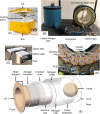A cryogenic 14-channel 13 C receiver array for 3T human head imaging
- PMID: 36321576
- PMCID: PMC10092528
- DOI: 10.1002/mrm.29508
A cryogenic 14-channel 13 C receiver array for 3T human head imaging
Abstract
Purpose: This article presents a novel 14-channel receive-only array for 13 C human head imaging at 3 T that explores the SNR gain by operating at cryogenic temperature cooled by liquid nitrogen.
Methods: Cryostats are developed to evaluate single-coil bench SNR performance and cool the 14-channel array with liquid nitrogen while having enough thermal insulation between the coils and the sample. The temperature distribution for the coil array is measured. Circuits are adapted to the -189°C environment and implemented in the 14-channel array. 13 C images are acquired with the array at cryogenic and room temperature in a 3T scanner.
Results: Compared with room temperature, the array at cryogenic temperature provides 27%-168% SNR improvement over all voxels and 47% SNR improvement near the image center. The measurements show a decrease of the element noise correlation at cryogenic temperature.
Conclusion: It is demonstrated that higher SNR can be achieved by cryogenically cooling the 14-channel array. A cryogenic array suitable for clinical imaging can be further developed on the array proposed. The cryogenic coil array is most likely suited for scenarios in which high SNR deep in a head and decent SNR on the periphery are required.
Keywords: MRI array; carbon imaging; cryogenic coil; head coil.
© 2022 The Authors. Magnetic Resonance in Medicine published by Wiley Periodicals LLC on behalf of International Society for Magnetic Resonance in Medicine.
Figures







References
-
- de Graaf RA. Basic principles. In Vivo NMR Spectroscopy: Principles and Techniques. 2nd ed. John Wiley & Sons; 2007:1‐42.
Publication types
MeSH terms
Substances
LinkOut - more resources
Full Text Sources
Medical

